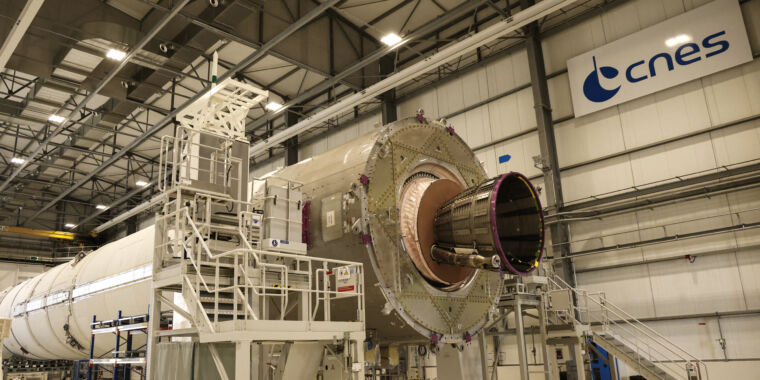LUDOVIC MARIN/AFP via Getty Images
There was a panel discussion at a space conference in Singapore 11 years ago that has since become legendary in certain corners of the space industry for what it reveals about European attitudes toward upstart SpaceX.
The panel included representatives from a handful of launch enterprises, including Europe-based Arianespace, and the US launch company SpaceX. At one point during the discussion, the host asked the Arianespace representative—its chief of sales in Southeast Asia, Richard Bowles—how the institutional European company would respond to SpaceX’s promise of lower launch costs and reuse with the Falcon 9 rocket.
“What I’m discovering in the market is that SpaceX primarily seems to be selling a dream, which is good. We should all dream,” Bowles replied. “I think a $5 million launch or a $15 million launch is a bit of a dream. Personally, I think reusability is a dream. How am I going to respond to a dream? My answer to respond to a dream is, first of all, you don’t wake people up.”
To be fair to Bowles, at the time of his remarks, SpaceX had only launched the Falcon 9 five times by the middle of 2013. But his condescension was nevertheless something to behold.
Later in the discussion, Bowles added that he did not believe launching 100 times a year, something that SpaceX was starting to talk about, was “realistic.” Then, in a moment of high paternalism, he turned to the SpaceX official on the panel and said, “You shouldn’t present things that are not realistic.”
In response, Barry Matsumori, a senior vice president at SpaceX, calmly said he would let his company’s response come through its actions.
Actions do speak louder than words
Eleven years later, of course, SpaceX is launching more than 100 times a year. The company’s internal price for launching a Falcon 9 is significantly less than $20 million. And all of this is possible through the reuse of the rocket’s first stage and payload fairings, each of which have now proven capable of flying 20 or more times.
One might think that, in the decade since, European launch officials would have learned their lesson. After all, last year, the continent had to resort to launching its valuable Euclid Space Telescope on a Falcon 9 rocket. This year, because the new European Ariane 6 rocket was not yet ready after myriad delays, multiple Galileo satellites have been launched and will be launched on the Falcon 9 rocket.
Some officials have taken note. In a candid commentary last year, European Space Agency chief Josef Aschbacher acknowledged that the continent faced an “acute” launcher crisis amid the Ariane 6 delays and the rise of SpaceX as a launch competitor. “SpaceX has undeniably changed the launcher market paradigm as we know it,” Aschbacher wrote. “With the dependable reliability of Falcon 9 and the captivating prospects of Starship, SpaceX continues to totally redefine the world’s access to space, pushing the boundaries of possibility as they go along.”
But not everyone got the message, it seems.
Next month, the Ariane 6 rocket should finally make its debut. It will probably be successful. Europe has excellent technical capabilities in regard to launch. But from day one, the Ariane 6 launch vehicle will cost significantly more than the Falcon 9 rocket, which has similar capabilities, and offer no provision for reuse. Certainly, it will meet Europe’s institutional needs. But it likely will not shake up the market, nor realistically compete with a fully reusable Falcon 9.
Who really needs to be woken up?
And what about Starship? If and when SpaceX can deliver it to the market, the next-generation rocket will offer a fully reusable booster with five times the lift capacity of the Ariane 6 rocket for half its cost or less. How can Europe hope to compete with that? The European Space Agency’s director of space transportation, Toni Tolker-Nielsen—who works for Aschbacher, it should be noted—said he’s not concerned.
“Honestly, I don’t think Starship will be a game-changer or a real competitor,” he said in an interview with Space News. “This huge launcher is designed to fly people to the Moon and Mars. Ariane 6 is perfect for the job if you need to launch a four- or five-ton satellite. Starship will not eradicate Ariane 6 at all.”
In one sense, Tolker-Nielsen is correct. Starship will not change how Europe gets its small and medium-sized satellites into space. Made and launched in Europe, the Ariane 6 rocket will be a workhorse for the continent. Indeed, some European officials are going so far as to press for legislation mandating that European satellites launch on European rockets.
But to say Starship will not be a game-changer represents the same head-in-the-sand attitude displayed by Bowles a decade ago with his jokes about not waking the deluded dreamers up. In hindsight, it’s clear that the dreamers were not SpaceX or its customers. Rather, they were European officials who had lulled themselves into thinking their dominance in commercial launch would persist without innovation.
While they slumbered, these officials ignored the rise of reusability. They decided the Ariane 6 rocket should look like its expendable predecessors, with solid rocket boosters. Meanwhile, following the rise of the Falcon 9, nearly all new rocket projects have incorporated a significant reusability component. It’s no longer just SpaceX founder Elon Musk saying companies need to pursue reuse or perish. Almost everyone is.
Perhaps someone should wake Tolker-Nielsen up.










